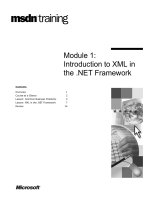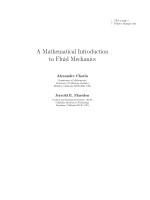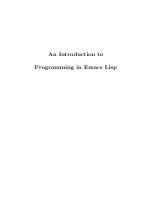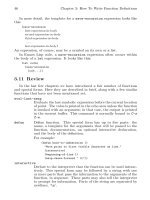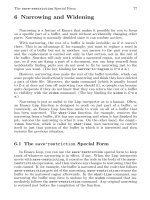Michael e taylor introduction to analysis in several variables advanced calculus (pure and applied undergraduate texts)
Bạn đang xem bản rút gọn của tài liệu. Xem và tải ngay bản đầy đủ của tài liệu tại đây (13.56 MB, 462 trang )
Introduction
to Analysis
in Several
Variables
Advanced Calculus
Michael E. Taylor
Introduction
to Analysis
in Several
Variables
Advanced Calculus
PIift/d�nAL/
UNDERGRADUA��' 46
Introduction
to Analysis
in Several
Variables
Advanced Calculus
Michael E. Taylor
• •• AMERICAN
MATHEMATICAL
. ..... SOCIETY
�;r AMS Providence, Rhode Island USA
.:;., "
EDITORIAL COMMITTEE
Gerald B. Folland (Chair) Steven J. Miller
Jamie Pommersheim Serge Tabachnikov
2010 Mathematics Subject Classification. Primary 26B05, 26BlO, 26B12, 26B15, 26B20.
For additional information and updates on this book, visit
www.amsoorg/bookpages/amstext-46
Library of Congress Cataloging-in-Publication Data
Names: Taylor, Michael E., 1946- author.
Title: Introduction to analysis in several variables : advanced calculus / Michael E. Taylor.
Description: Providence, Rhode Island American Mathematical Society, [2020] I Series: Pure
and applied undergraduate texts, 1943-9334 ; volume 46 I Includes bibliographical references
and index.
Identifiers: LCCN 20200097351 ISBN 9781470456696 (paperback) I ISBN 9781470460167 (ebook)
Subjects: LCSH: Calculus. I FUnctions of several real variables. I Functions of several complex
variables. I AMS: Real functions - FUnctions of several variables - Continuity and differentia
tion questions. I Real functions - FUnctions of several variables - Implicit function theorems,
Jacobians, transformations with several variables. I Real functions - FUnctions of several
variables - Calculus of vector functions. I Real functions - FUnctions of several variables -
Integration: length, area, volume. I Real functions - FUnctions of several variables - Integral
formulas (Stokes, Gauss, Green, etc.).
Classification: LCC QA303.2 .T38 2020 I DDC 515-dc23
LC record available at />
Copying and reprinting. Individual readers of this publication, and nonprofit libraries acting
for them, are permitted to make fair use of the material, such as to copy select pages for use
in teaching or research. Permission is granted to quote brief passages from this publication in
reviews, provided the customary acknowledgment of the source is given.
Republication, systematic copying, or multiple reproduction of any material in this publication
is permitted only under license from the American Mathematical Society. Requests for permission
to reuse portions of AMS publication content are handled by the Copyright Clearance Center. For
more information, please visit www.ams.org/publications/pubpermissions.
Send requests for translation rights and licensed reprints to
© 2020 by the American Mathematical Society. All rights reserved.
The American Mathematical Society retains all rights
except those granted to the United States Government.
Printed in the United States of America.
o The paper used in this book is acid-free and falls within the guidelines
established to ensure permanence and durability.
Visit the AMS home page at />
10 9 8 7 6 5 4 3 2 1 25 24 23 22 21 20
Contents
Preface vii
Some basic notation xi
Chapter 1. Background 1
1.1. One-variable calculus 2
1.2. Euclidean spaces 17
1.3. Vector spaces and linear transformations 22
1.4. Determinants 31
Chapter 2. Multivariable differential calculus 39
2.1. The derivative 39
2.2. Inverse function and implicit function theorems 56
2.3. Systems of differential equations and vector fields 68
Chapter 3. Multivariable integral calculus and calculus on surfaces 87
3.1. The Riemann integral in n variables 88
3.2. Surfaces and surface integrals 117
3.3. Partitions of unity 145
3.4. Sard's theorem 146
3.5. Morse functions 147
3.6. The tangent space to a manifold 148
Chapter 4. Differential forms and the Gauss-Green-Stokes formula 153
4.1. Differential forms 154
4.2. Products and exterior derivatives of forms 160
4.3. The general Stokes formula 164
-
v
vi Contents
4.4. The classical Gauss, Green, and Stokes formulas 169
4.5. Differential forms and the change ofvariable formula 179
Chapter 5. Applications of the Gauss-Green-Stokes formula 185
5.1. Holomorphic functions and harmonic functions 186
5.2. Differential forms, homotopy, and the Lie derivative 200
5.3. Differential forms and degree theory 205
Chapter 6. Differential geometry of surfaces 221
6.1. Geometry ofsurfaces I: geodesics 225
6.2. Geometry of surfaces II: curvature 238
6.3. Geometry ofsurfaces III: the Gauss-Bonnet theorem 252
6.4. Smooth matrix groups 265
6.5. The derivative of the exponential map 283
6.6. A spectral mapping theorem 288
Chapter 7. Fourier analysis 291
7.1. Fourier series 294
7.2. The Fourier transform 310
7.3. Poisson summation formulas 330
7.4. Spherical harmonics 332
7.5. Fourier series on compact matrix groups 372
7.6. Isoperimetric inequality 378
Appendix A. Complementary material 381
A.1. Metric spaces, convergence, and compactness 382
A.2. Inner product spaces 393
A.3. Eigenvalues and eigenvectors 398
A.4. Complements on power series 402
A.5. The Weierstrass theorem and the Stone-Weierstrass theorem 408
A.6. Further results on harmonic functions 410
A.7. Beyond degree theory-introduction to de Rham theory 416
Bibliography 437
Index 441
Preface
This text was produced for the second part of a two-part sequence on advanced cal
culus, whose aim is to provide a firm logical foundation for analysis, for students who
have had threesemesters ofcalculus and a course in linear algebra. The first part treats
analysis in one variable, and the text [49] was written to cover that material. The text at
hand treats analysis in several variables. These two texts can be used as companions,
but they are written so that they can be used independently, if desired.
Chapter 1 treats background needed for multivariable analysis. The first section
gives a brief treatment of one-variable calculus, including the Riemann integral and
the fundamental theorem ofcalculus. This section distills material developed in more
detail in the companion text [49]. We have included it here to facilitate the indepen
dent use of this text. Subsequent sections in Chapter 1 present the basic linear algebra
background of use for the rest of this text. They include rnaterial on n-dimensional
Euclidean spaces and other vector spaces, on linear transformations on such spaces,
and on determinants of such linear transformations.
Chapter 2 develops multidimensional differential calculus on domains in n-dimen
sional Euclidean space Itn. The first section defines the derivative of a differentiable
map F : (') .... Itm, at a point x E ('), for (') open in Itn, as a linear map from Itn to
Itm, and establishes basic properties, such as the chain rule. The next section deals with
the inverse function theorem, giving a condition for such a map to have a differentiable
inverse, when n = m. The third section treats n X n systems of differential equations,
bringing in the concepts ofvector fields and flows on an open set (') E Itn. While the
emphasis here is on differential calculus, we do make use of integral calculus in one
variable, as exposed in Chapter l.
Chapter 3 treats multidimensional integral calculus. We define the Riemann in
tegral for a class of functions on Itn and establish basic properties, including a change
ofvariable formula. We then study smooth m-dimensional surfaces in Itn, and extend
-
vii
viii Preface
the Riemann integral to a class of functions on such surfaces. Going further, we ab
stract the notion of surface to that of a manifold, and study a class of manifolds known
as Riemannian manifolds. These possess an object known as a metric tensor. We also
define the Riemann integral for a class of functions on such manifolds. The change of
variable formula is instrumental in this extension of the integral.
In Chapter4 we introduce a further class ofobjects that can be defined on surfaces,
differentialforms. A k-form can be integrated over a k-dimensional surface, endowed
with an extra structure, an orientation. Again the change of variable formula plays a
role in establishing this. Important operations on differential forms include products
and the exterior derivative. A key result of Chapter 4 is a general Stokes formula, an
important integral identity that can be seen as a multidimensional version of the fun
damental theorem of calculus. In §4.4 we specialize this general Stokes formula to
classical cases, known as theorems of Gauss, Green, and Stokes.
A concluding section of Chapter 4 makes use of material on differential forms to
give another proof of the change of variable formula for the integral, much different
from the proof given in Chapter 3.
Chapter 5 is devoted to several applications of the material on the Gauss- Green
Stokes theoremsfrom Chapter 4. In §5.1 we use Green's theorem to derive fundamental
properties of holomorphic functions of a complex variable. Sprinkled throughout ear
lier sections are some allusions to functions of complex variables, particularly in some
of the exercises in §§2.1-2.2. Readers with no previous exposure to complex variables
might wish to return to these exercises after getting through §5.1. In this section, we
also discuss some results on the closelyrelated study of harmonic functions. One result
is Liouville's theorem, stating that a bounded harmonic function on all of Rn must be
constant. When specialized to holomorphic functions on C = R', this yields a proof of
the fundamental theorem of algebra.
In §5.2 we define the notion of smoothly homotopic maps and consider the be
havior of closed differential forms under pullback by smoothly homotopic maps. This
material is then applied in §5.3,whichintroducesdegree theoryand derives some inter
esting consequences. Key results include the Brouwer fixed point theorem, the Jordan
Brouwer separation theorem (in the smooth case), and the study of critical points of a
vector field tangent to a compact surface, and connections with the Euler characteris
tic. We also show how degree theoryyields another proof of the fundamental theorem
of algebra.
Chapter 6 applies results of Chapters 2-5 to the study of the geometry of surfaces
(and more generally of Riemannian manifolds). Section 6.1 studies geodesics, which
are locally length-minimizing curves. Section 6.2 studies curvature. Several varieties
of curvature arise, including Gauss curvature and Riemann curvature, and it is of great
interest to understand the relations between them. Section 6.3 ties the curvature study
of §6.2 to material on degree theory from §5.3, in a result known as the Gauss-Bonnet
theorem.
Section 6.4 studies smooth matrix groups, which are smooth surfaces in M(n, F)
that are also groups. These carry left and right invariant metric tensors, with important
Preface ix
consequences for the application of such groups to other aspects of analysis, including
results presented in §7A.
Chapter 7 is devoted to an introduction to multidimensional Fourier analysis. Sec
tion 7.1 treats Fourier series on the n-dimensional torus un, and §7.2 treats the Fourier
transform for functions on Rn. Section 7.3 introduces a topic that ties the first two to
gether, known as Poisson's summation formula. We apply this formula to establish a
classical result of Riemann, his functional equation for the Riemann zeta function.
The material in §§7.1-7.3 bears on topics rather different from the geometrical ma
terial emphasized in the latter part of Chapter 3 and in Chapters 4-6. In fact, this part
of Chapter 7 could be tackled right after one gets through §3.1. On the other hand,
the last three sections of Chapter 7 make strong contact with this geometrical mate
rial. Section 704 treats Fourier analysis on the sphere sn-l, which involves expanding
a function on sn-l in terms ofeigenfunctions of the Laplace operator !J.s, arising from
the Riemannian metric on sn-l. This study of course includes integrating functions
oversn-1 Italso brings in the matrix group SO(n), introduced in Chapter 3, which acts
on each eigenspace Vk of !J.s, and its subgroup SO(n - 1), and makes use of integrals
over SO(n - 1). Section 704 also makes use of the Gauss-Green-Stokes formula and ap
plications to harmonic functions, from §§4A and 5.1. We believe the reader will gain a
good appreciation of the utility of unifying geometrical concepts with those aspects of
Fourier analysis developed in the first part of Chapter 7.
We complement §7A with a brief discussion of Fourier series on compact matrix
groups, in §7.5.
Section 7.6 deals with the purely geometric problem of showing that, among
smoothlybounded planar domains 0 c R' with fixed area, the disks have the smallest
perimeter. This is the two-dimensional isoperimetric inequality. Its placement here is
due to the fact that its proof is an application ofFourier series.
The textendswith a collection ofappendices, some giving furtherbackground ma
terial, others providing complements to results of the main text. Appendix A.1 covers
some basic notions of metric spaces and compactness used from time to time through
out the text, such as in the study of the Riemann integral and in the proof of the fun
damental existence theorem for ODE. As is the case with §1.1, Appendix A.1 distills
material developed at a more leisurely pace in [49], again serving to make this text
independent of the first one.
Appendices A.2 and A.3 complement results on linear algebra presented in Chap
ter 1 with some further results. Appendix A.2 treats a general class of inner product
spaces, both finite and infinite dimensional. Treatments in the latter case are relevant
to results on Fourier analysis in Chapter 7. Appendix A.3 treats eigenvalues and eigen
vectors oflinear transformations on finite-dimensionalvector spaces, providing results
useful in various places, from §2.1 to §6.6.
Appendix AA discusses the remainder term in the power series ofa function. Ap
pendix A.5 deals with the Weierstrass theorem on approximating a continuous func
tion by polynomials, and an extension, known as the Stone-Weierstrass theorem, a
useful tool in analysis, with applications in §§5.3, 7.1, and 704. Appendix A.6 builds on
material on harmonic functions presented in Chapters 5 and 7. Results range from a
x Preface
removable singularity theorem to extensions of Liouville's theorem. Appendix A.7 in
troduces de Rham cohomology, as an extension of degree theory, developed in Chapter
5.
We point out some distinctive features of this treatment ofadvanced calculus.
1) Applications of the Gauss-Green-Stokes formulas. These formulas form a high
point in any advanced calculus course, but we do not want them to be seen as
the culmination of the course. Their significance arises from their many appli
cations. The first application we treat is to the theory of functions of a complex
variable, including the Cauchy integral theorem and basic consequences. This
basically constitutes a mini-course in complex analysis. (A much more extensive
treatment can be found in [51].) We also derive applications to the study of har
monic functions, in n variables, a study that is closely related to complex analysis
when n = 2.
We also apply differential forms and the Stokes formula to results of a topo
logical flavor, involving a set of tools known as degree theory. We start with a
result known as the Brouwer fixed point theorem. We give a short proof, as a di
rect application of the Stokes formula, thus making this theorem a precursor to
degree theory rather than an application.
2) The unity ofanalysisandgeometry. This startswithcalculus on surfaces, comput
ing surface areas and surface integrals, given in terms of the metric tensors these
surfaces inherit, but it proceeds much further. There is the question of finding
geodesics, shortest paths, described by certain differential equations, whose co
efficients arise from the metric tensor. Another issue is what makes a curved
surface curved. One particular measure is called the Gauss curvature. There are
formulas for the integrated Gauss curvature, which in turn make contact with
degree theory. Such matters are examples of connections uniting analysis and
geometry, and is pursued in the text.
Other connections arise in the treatment of Fourier analysis. In addition to
Fourier analysis on Euclidean space, the text treats Fourier analysis on spheres.
Matrix groups, such as rotation groups SO(n), make an appearance, both as tools
for studying Fourier analysis on spheres and as further sources of problems in
Fourier analysis, thereby expanding the theater in which we bring to bear tech
niques of advanced calculus developed here.
Acknowledgment
During the preparation of this book, my research has been supported by a number of
NSF grants, most recently DMS-1500817.
Some basic notation
This list of some basic notation will be used throughout the text.
R is the set of real numbers.
C is the set of complex numbers.
Z is the set of integers.
Z+ is the set of integers 2: O.
N is the set of integers 2: 1 (the natural numbers).
Q is the set of rational numbers.
x E IR. means x is an element of IR, i.e., x is a real number.
(a, b) denotes the set of x E R such that a < x < b.
[a, b] denotes the set of x E R such that a :S x :S b.
(x E R : a :S x :S b) denotes the set of x in R such that a :S x :S b.
[a, b) = {x E R : a :S x < b}and (a, b] = {x E R : a < x :S b}.
Z = x - iy ifz = x + iy E C, x, Y E R.
-
xi
xii Some basic notation
o denotes the closure of the set D.
f : A --+ B denotes that the function f takes points in the setA to points in B. One also
says f maps A to B.
x --+ Xo means the variable x tends to the limit xo.
f(x) = O(x) means f(x)/x is bounded. Similarly g(E)
bounded.
f(x) = o (x) as x --+ a (resp., x --+ 00) means f(x)/x --+ a as x tends to the specified
limit.
S = sup la n n l means S is the smallest real number that satisfies S 2: lan l for all n. If
there is no such real number, then we take S = +00.
lim sup lakl = lim (sup lakl).
k--+oo n--+oo k'::?n
Chapter 1
Background
This first chapter provides background material on one-variable calculus, the geom
etry of n-dimensional Euclidean space, and linear algebra. We begin in §1.1 with a
presentation of the elements of calculus in one variable. We first define the Riemann
integral for a class of functions on an interval. We then introduce the derivative and
establish thejUndamental theorem ofcalculus, relating differentiation and integration
as essentially inverse operations. Further results are dealt with in the exercises, such
as the change of variable formula for integrals and the Taylor formula with remainder
for power series.
Nextwe introduce the n-dimensional Euclidean spaces Rn, in §1.2. The dot prod
uct on Rn gives rise to a norm, hence to a distance function, making Rn a metric space.
(More general metric spaces are studied in Appendix A.l.) We define the notion of
open and closed subsets of Rn, of convergent sequences, and of compactness, and we
establish that nonempty closed, bounded subsets of Rn are compact. This material
makes use of results on the real line R, dealt with at length in [49], and reviewed in
Appendix A.l.
The spaces Rn are special cases ofvector spaces, explored in greater generality in
§1.3. We also study linear transformations T : V ... W between two vector spaces. We
define the class of finite-dimensional vector spaces, and show that the dimension of
such a vector space is well defined. If V is a real vector space and dim V = n, then V is
isomorphic to Rn. Linear transformations from Rn to Rm are given by m X n matrices.
In §1.4 we define the determinant, detA, of an n X n matrix A, and show that A is
invertible if and only if detA '" O. In Chapter 2, such linear transformations arise as
derivatives of nonlinear maps, and understanding the behavior of these derivatives is
basic to manykeyresults in multivariable calculus, both in Chapter 2 and in subsequent
chapters.
-
1
2 1. Background
1 . 1 . One-variable calculus
In thisbriefdiscussion ofone-variable calculus, we introduce the Riemann integral and
relate it to the derivative. We will define the Riemann integral of a bounded function
over an interval I = [a, b1 on the real line. For now, we assume f is real valued. To
start, we partition I into smaller intervals. A partition l' of I is a finite collection of
subintervals (Jk : a :S k :S NJ, disjoint except for their endpoints, whose union is I. We
can order the Jk so thatJk = [Xko xk+d, where
(1.1.1)
We call the points Xk the endpoints of1'. We set
(1.1.2) maxsize (1') = OmaxN li(Jk)'
�k�
We then set
Icp(f) = � supf(x)li(h),
k Ik
(1.1.3) L/f) = � inff(x) li(Jk)'
k Ik
Definitions of sup and inf are given in (A.1.17)-(A.1.18). We call Icp(f) and £p(f) the
upper sum and lower sum, respectively, of f, associated to the partition 1'. See Figure
1.1.1 for an illustration. Note that £pU) :S [p(f). These quantities should approximate
the Riemann integral off, if the partition l' is sufficientlyfine.
To be more precise, if l' and Q are two partitions of I, we say l' refines Q and write
l' >- Q, if l' is formed by partitioning each interval in Q. Equivalently, l' >- Q if and
only if all the endpoints of Q are also endpoints of 1'. It is easy to see that any two
partitions have a common refinement; just take the union of their endpoints, to form a
new partition. Note also that refining a partition lowers the upper sum of f and raises
its lower sum,
(1.1.4)
a b
Figure 1.1.1. Upper and lower sums
1.1. One-variable calculus 3
Consequently, if 1) are any two partitions and Q is a common refinement, we have
(1.1.5)
Now, whenever f : J --+ R is bounded, the following quantities are well defined:
(1.1.6) I (f) = inf Icp(f), I (f) = sup LpCf),
:PEI1(I)
:PEI1(I)
where II(I) is the set ofall partitions ofJ. We call I (f) the lower integral off andI(f) its
upper integral. Clearly, by (1.1.5), I(f) :SI(f). We then say thatf is Riemann integrable
providedI(f) = J(f), and in such a case, we set
(1.1.7) 1 f(x)dx = J f(x)dx = I(f) = I(f). b
I
We will denote the set of Riemann integrable functions on J by :fI (I).
We derive some basic properties of the Riemann integral.
Proposition 1.1.1. Iff, g E :fI (I), then f + g E :fI (I), and
(1.1.8) J(f + g)dX = Jfdx + Jgdx.
I I I
Proof. IfJk is any subinterval ofJ, then
sup(f + g) :S sup f + sup g and inf(f + g) 2: inf f + inf g,
Ik Ik Ik Ik Ik Ik
so, for any partition :P, we haveI:p(f + g) :S I:p(f) +I:p(g). Also, using common refine
ments, we can simultaneously approximate I(f) and I(g) byI:p(f) and I:p(g) and the
same goes forI(f + g). Thus the characterization (1.1.6) impliesI(f + g) :S I (f) +I (g).
A parallel argument implies I (f + g) 2: I (f) + I (g), and the proposition follows. D
Next, there is a fair supply of Riemann integrable functions.
Proposition 1.1.2. Iff is continuous on J, then f isRiemann integrable.
Proof. Any continuous function on a compact interval is bounded and uniformly con
tinuous (see Propositions A.1.15 and A.1.16). Let w(8) be a modulus of continuity for
f, so
(1.1.9) Ix - yl :S 8 ==} If(x) - f(y)1 :S w(8), w(8) --+ 0 as 8 --+ O.
Then
(1.1.10)
which yields the proposition. D
4 1. Background
We denote the set ofcontinuous functions on Iby C(I). Thus Proposition 1.1.2 says
C(I) c :fI (I).
The proof of Proposition 1.1.2 provides a criterion on a partition guaranteeing that
11'(f) and I1'(f) are close to h f dx when f is continuous. We produce an extension,
giving a condition under which 11'(f) and I(f) are close, and I1'(f) and I(f) are close,
given f bounded on I. Given a partition 1'0 ofI, set
(1.1.11) minsize(1'o) = min{e(Jk) : Jk E 1'0}.
Lemma1.1.3. Letl' and Q be twopartitions ofI. Assume
(1.1.12) maxsize(1') :S � minsize(Q).
Let IfI :S MonI. Then -11'(f) :s -Io(f) + T2Me(I),
(1.1.13) I1'(f) 2: Io(f) - 2�e(I).
Proof. Let 1', denote the minimal common refinement of l' and Q. Consider on the
one hand those intervals in l' thatare contained in intervals in Q and on the other hand
those intervals in l' that are not contained in intervals in Q. Each interval of the first
type is also an interval in 1',. Each interval of the second type gets partitioned, to yield
two intervals in 1',. Denote by 1',b the collection of such divided intervals. By (1.1.12),
the lengths of the intervals in 1',b sum to :S e(I)/k. It follows that
II1'(f) - I1\(f)I :S � 2Me(J) :S 2Me�),
JEP1b
and similarly II1'(f) - I1\(f)1 :S 2Me(I)/k. Therefore
-11'(f) :S -11',(f) + T2Me(l),
Since also 11\(f) :S Io(f) and I1\(f) 2: Io(f), we obtain (1.1.13). D
The following consequence is sometimes called Darboux's theorem.
Theorem1.1.4. Let 1'v be a sequence ofpartitions ofI into v intervals Jvb 1 :S k :S v,
such that
maxsize(1'v) --+ O.
Iff : I --+ It is bounded, then
(1.1.14)
Consequently, v
(1.1.15) f E :fI(I) = I(f) = vli--m+oo � f(IVk)e(Jvk),
k=l
forarbitrary IVk E Jvb inwhichcase the limitishf dx.
1.1. One-variable calculus 5
Proof. As before, assume I II :S M. Pick E = 11k > O. Let Q be a partition such that
Now pick N such that I (f) :SIo(f) :S I(f) + E,
£ (f) 2: £o(f) 2: £(f) - £.
v � N ===? maxsize :Pv :::; E minsize Q.
Lemma 1.1.3 yields, for v 2: N,
Hence, for v 2: N, Icp/ f) :S Io(f) + 2MIi(I)E,
Lpv(f) 2: £o(f) - 2MIi(I)£.
I(f) :S 11'/ f) :S I(f) + [2MIi(I) + l]E,
£(f) 2: £1'v(f) 2: £(f) - [2MIi(I) + 1]£.
This proves (1.Ll4). D
Remark. The sums on the right side of (1.1.15) are called Riemann sums, approxi
mating hi dx (when I is Riemann integrable).
Remark. A second proof of Proposition 1.1.1 can readily be deduced from Theorem
Ll.4.
One should be warned that once such a specific choice of 1'v and IVk has been
made, the limit on the right side of (loLlS) might exist for a bounded function I that
is not Riemann integrable. This and other phenomena are illustrated by the following
example of a function which is not Riemann integrable. For x E J, set
(1.Ll6) il(x) = 1 if x E Q, il(x) = 0 if x II' Q,
where Q is the set of rational numbers. Now every interval J c J of positive length
contains points in Q and points notin Q, so foranypartition l' ofIwe haveI1' (il) = Ii (l)
and £1' (il) = 0, hence
(1.Ll7) I(il) = 1i(I), £(il) = O.
Note that if 1'v is a partition of J into v equal subintervals, then we could pick each IVk
to be rational, in which case the limit on the right side of (loLlS) would be 1i(I), or we
could pick each IVk to be irrational, in which case this limit would be zero. Alterna
tively, we could pick half of them to be rational and half to be irrational, and the limit
would be 1i (I)/2.
Associated to the Riemann integral is a notion of size of a set S, called content. If
S is a subset ofJ, define the characteristicfunction,
(1.Ll8) Xs(x) = 1 if X E S, 0 if x II' s.
We define uppercontent cont+ and lowercontent cont- by
(1.Ll9) cont+(S) = I(Xs), connS) = £(Xs)·
6 1. Background
We say S has content, or is contented if these quantities are equal, which happens if and
only if XS E :R(I), in which case the common value of cont+(S) and cont-(S) is
(1.1.20) m(S) = J Xs(x)dx.
I
It is easy to see that
(1.1.21) N
cont+(S) = inf! � Ii (lk) : S el, U. . . UlN]'
k=l
where lk are intervals. Here, we require S to be in the union of afinite collection of
intervals.
See the appendix at the end of this section for a generalization of Proposition 1.1.2,
which gives a sufficient condition for a bounded function to be Riemann integrable on
J, in terms of the upper content of its set of discontinuities.
There is a more sophisticated notion of the size of a subset of J, called Lebesgue
measure. The key to the construction of Lebesgue measure is to cover a set S by a
countable(either finite orinfinite) setofintervals. The outermeasureofS eJis defined
by
(1.1.22) m*(S) = inf! � Ii (h) : S e U h].
k�l
k�l
Here (hl is a finite or countably infinite collection of intervals. Clearly
(1.1.23) m*(S) :s cont+(S).
Xs Note that ifS = Jn Q, then = ,9, defined by (1.1.16). In this case it is easy to see that
cont+(S) = 1i(I), but m*(S) = O. Zero is the "right" measure of this set. More material
on the development of measure theory can be found in a number ofbooks, including
[17] and [47].
It is useful to note that h I dx is additive in J, in the following sense.
Proposition 1.1.5. Ifa < b < c, I : [a, c]--+ R, I, = /lla,bl' I, = /llb,cl, then
(1.1.24) I E :R([a,cJ)=/, E :R([a,bJ) and /, E :R([b,cJ),
and, ilthisholds,
(1.1.25)
Proof. Since any partition of [a,c] has a refinement for which b is an endpoint, we
may as well consider a partition :P a partition of [b, c]. Then = :P, U:P" where :P, is a partition of [a, b] and :P, is
(1.1.26)
so
(1.1.27)
